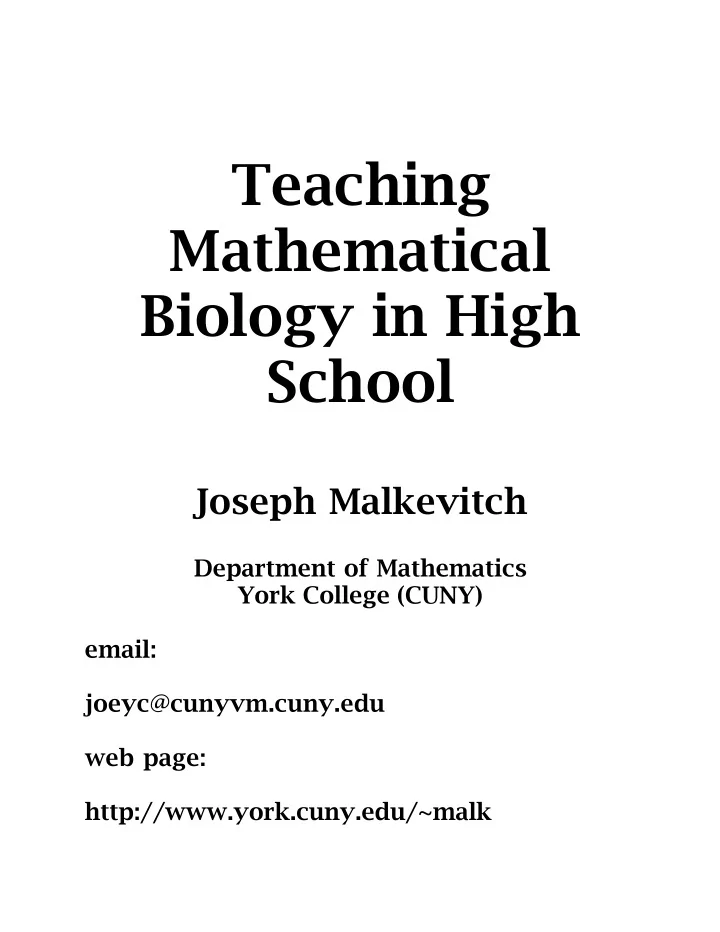

Teaching Mathematical Biology in High School Joseph Malkevitch Department of Mathematics York College (CUNY) email: joeyc@cunyvm.cuny.edu web page: http://www.york.cuny.edu/~malk
Why teach about the connections between mathematics and biology in high school? a. Topics in the traditional high school curriculum give insight into biology b. Make students aware of the role that mathematics has in biology c. Encourage students to pursue taking mathematics in college
Population biology: a. Human population growth b. Bacterial growth c. Virus growth d. Host/parasite relations e. Predator-prey systems
Epidemics: a. AIDS b. Syphilis c. Gonorrhea d. Marburg virus e. Bird flu (and other flus)
Classical Genetics: a. Hardy-Weinberg equations b. Inbreeding c. Selection ------------------------------ Tool: Probability theory
Bioinformatics: a. Database design b. Algorithms for edit distance c. Algorithms for tree construction d. String algorithms
Phylogenetic trees: a. distance between trees b. representing distance matrices using trees
Bioinformatics, genomics, computational, molecular biology, computational genetics, computational biology :
We are all familiar with the concept of distance: Crow flies distance (or Euclidean distance) and urban dwellers with: Taxicab distance
(3, 4) (5, 4) (0, 4) C (0, 2) (0, 1) B A (0,0) (5, 0) (1,0) (2, 0) (3, 0)
Abstract distance:
Examples: * colors * insulin molecules * literary manuscripts * DNA sequences * kinds of grapes
* languages * odors * student programs (or term papers) * functions * graphs of functions * ideas (inventions)
* graphs * matrices * sets * songs * art works * faces
Given "Points" x and y: a . d(x,y) ≥ 0 b . d(x,y) = 0 if and only if x = y. c . d(x,y) = d(y,x) d . d(x,y) + d(y,x) ≥ d(x,z) (here z is a third point)
Weighted graph: 20 14 8 6 D A B C E (Ultrametric tree; there is a "clock.")
We can interpret the weights on the internal vertices of this tree as telling the "date" of the most recent common ancestor of the objects represented by the leaves of the tree.
We can display the distances between pairs of leaves (given by the weight at the internal vertex in a matrix (table) called a distance matrix .
20 14 8 6 D A B C E B A C D E A 20 20 6 0 20 B 20 20 20 0 C 8 0 14 D 0 14 E 0
Theorem: (3 point condition) A distance matrix has an ultrametric tree representation if and only if for any triple of i, j, and k (of rows of the matrix) the maximum of the entries D(i,j), D(i,k), and D(j,k) are equal.
Additive tree: E A 7 1 3 2 B 5 2 D 6 C and its distance matrix: Distance A B C D E A 0 11 15 3 11 B 11 0 8 12 14 C 15 8 0 16 18 D 3 12 16 0 18 E 11 14 18 18 0
Distance relations for the 4 point condition: a b c d d a, b + d c, d ‹ d a, d + d b, c = d a,c + d b, d
Theorem: A distance matrix can be represented by an additive tree if and only if it satisfies the four point condition .
Mathematical tools for biologists: * difference equations * Calculus methods ~ Differential equations ~ Partial differential equations
* Mathematical modeling a. Matrices b. graphs and digraphs c. equations and functions d. dynamical systems
Resource Sheet : 1. Original papers available on the web: a. scholar.google.com b. citeseer.nj.nec.com/cs 2. Survey articles: www.ams.org/featurecolumn/
DIMACS Educational Modules: Free access: http://dimacs.rutgers.edu/Publica tions/Modules/moduleslist.html
Dimacs Modules
Content: * Discrete mathematics * Computer science * Appropriate applications * Nifty examples
We are looking for: * Very recent work * New slant on old material * Non-standard application * Pulling together materials not easily found in one place * Insightful example covered in detail
Contact person: Joseph Malkevitch email: joeyc@cunyvm.cuny.edu --------------------------------------- Mathematics Department York College (CUNY) Jamaica, New York 11451 ----------------------------------- (or Mel Janowitz, DIMACS Associate Director)
Recommend
More recommend